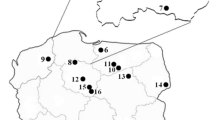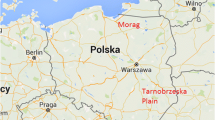Abstract
Total mercury concentrations were determined by cold-vapor atomic absorption spectroscopy in 240 composite samples of the caps, 240 of the stalks, and 16 of the whole fruiting bodies of 13 species of wild mushrooms and in 256 samples of underlying soil substrate collected from the Borecka Forest and the adjacent area in 1998. The area of the study is a background site with no known local sources of mercury emission. The mercury concentrations of the fruiting bodies varied largely (range between 14 and 14,000 ng/g dry weight) depending on the site and mushroom species investigated, but were less varied in soil samples (between 5 and 86 ng/g dry weight). The fruiting bodies of king bolete (Boletus edulis) showed greatest content of mercury. King bolete and yellow-cracking bolete (Xerocomus subtomentosus) collected from the Borecka Forest both contained in the caps around threefold greater concentrations of mercury than were noted for the same species collected from the surrounding area with 9,900 ± 2,700 and 3,600 ± 1,400, and 480 ± 190 and 160 ± 70 ng/g dry weight, respectively. Apart from the king bolete, relatively elevated concentrations of mercury were quantified also in a whole fruiting bodies of common puffball (Lycoperdon perlatum) with 3,400 ± 1,300 ng/g as well as in the caps and stalks of common scaber stalk (Leccinum scabrum) with 1,200 ± 740 and 1,100 ± 380 ng/g dry weight. In other species investigated, the mercury concentrations were below 1,000 ng/g dry weight, and the smallest values were noted for crab-scended brittle gills (Russula xerampelina) with 60 ± 20 in the caps and 40 ± 20 ng/g dry weight in the stalks. For the species such as larch bolete, bay bolete (Xerocomus badius), yellow-cracking bolete, king bolete, common scaber stalk, fly agaric (Amanita muscaria), crab-scented brittle gills, honey mushroom (Amariella mellea) and safron milk cap (Lactarius deliciosus) a positive correlation (0.01 < p < 0.05) between the mercury content and size (diameter) of the caps was found, and in some cases also between mercury content of the stalks and size (height) of the fruiting body. The bioconcentration factor (BCF) values of total mercury were greatest for king bolete, i.e., 250 ± 65 in the caps and 140 ± 47 in the stalks, while for the other species investigated were between 200 ± 91 and 1.8 ± 0.5 in the caps, and 94 ± 57 and 1.7 ± 0.4 in the stalks. Nevertheless, despite great values of BCF of mercury indicated for some species and also a positive correlation between mercury content of the caps/stalks and underlying soil substrate, subsequent coefficients of determination were usually below 40%, and only for bay bolete (stalk), yellow-cracking bolete (cap), common scaber stalk (cap), hard bolete (Leccinum griseum) (cap, stalk), crab-scented gills (stalk), and honey mushroom (cap) were up to 68, 82, 42, 82, 51, 74, and 45%, respectively. The values of the cap/stalk Hg quotient were greatest for larch bolete (Suillus flavus) collected from the Borecka Forest (4.4 ± 1.3) and for honey mushroom (2.7 ± 0.9) from the adjacent area.
Similar content being viewed by others
Author information
Authors and Affiliations
Additional information
Received: 26 March 2001/Accepted: 5 August 2001
Rights and permissions
About this article
Cite this article
Falandysz, J., Gucia, M., Skwarzec, B. et al. Total Mercury in Mushrooms and Underlying Soil Substrate from the Borecka Forest, Northeastern Poland. Arch. Environ. Contam. Toxicol. 42, 145–154 (2002). https://doi.org/10.1007/s00244-001-0026-1
Issue Date:
DOI: https://doi.org/10.1007/s00244-001-0026-1




